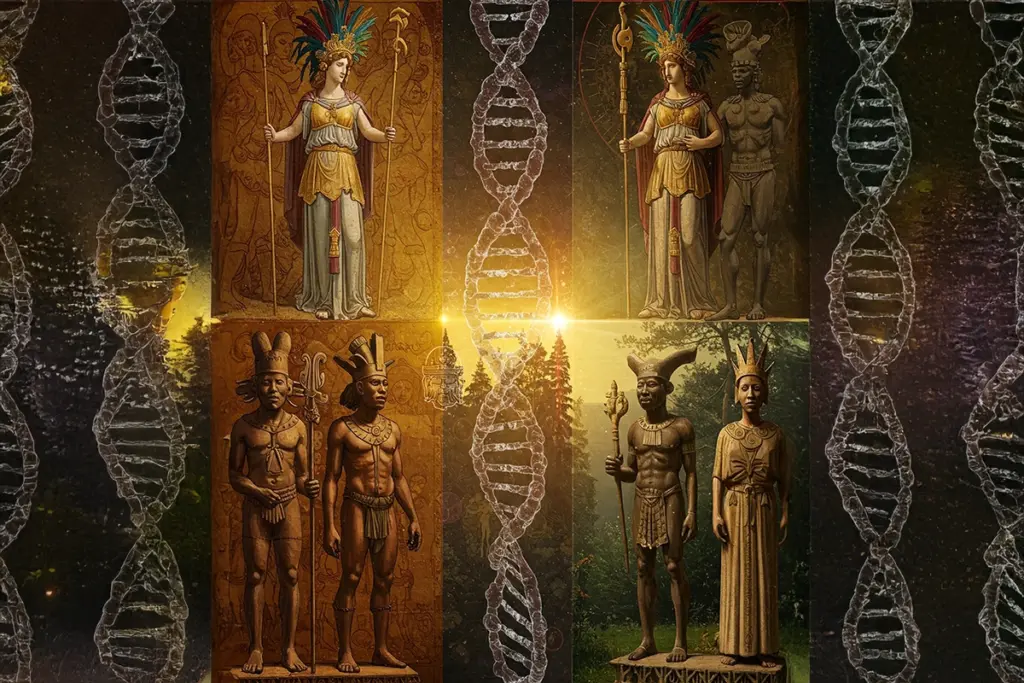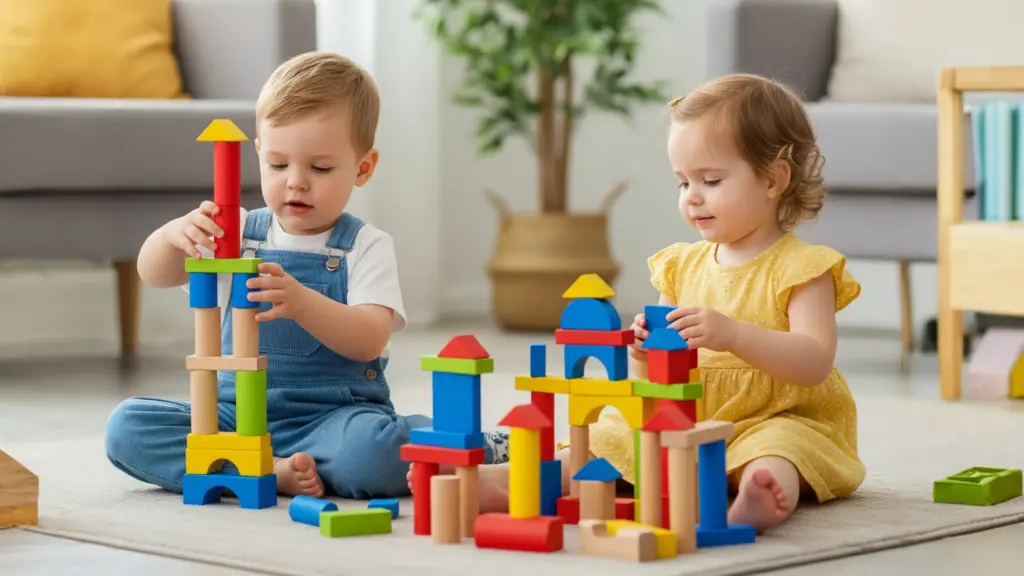What if technology could reveal hidden insights about your twins health, behavior, and future before they even take their first steps? For parents of twins, the “technology in twin research” revolution is unlocking answers that were once unimaginable. From DNA sequencing that deciphers genetic quirks to AI-driven twin registries predicting health risks, cutting-edge tools are reshaping how we understand twin development and empowering families with actionable knowledge.
Historically, twin studies relied on surveys and basic observations. Today, advancements like whole-genome analysis and machine learning algorithms analyze vast datasets, pinpointing how genes and environment shape everything from academic success to disease susceptibility. For parents, this means personalized healthcare plans, early interventions, and a deeper grasp of what makes each twin unique.
In this article, we’ll explore:
- How DNA sequencing uncovers genetic differences in identical twins.
- The role of AI-driven registries in predicting risks like prematurity or diabetes.
- Practical ways parents can leverage these breakthroughs for their twins wellbeing.
Whether you’re expecting twins or raising them, this tech-driven journey will transform how you see their bond and their future.
The Evolution of Twin Studies
From Questionnaires to Quantum Computing: How Twin Research Entered the Digital Age
Twin studies have always been a cornerstone of science, but their methods have evolved dramatically. Let’s break down this transformation:
The Early Days: Surveys and Simplicity
In the 20th century, twin research hinged on basic tools:
- Paper questionnaires tracking habits, illnesses, and personalities.
- Small sample sizes, often limited to local communities.
- Manual data analysis, prone to human error.
Landmark projects like the Minnesota Twin Study (external link: University of Minnesota) made strides in the 1980s by reuniting separated twins, but they lacked today’s precision.
The Genomics Revolution
The 2000s brought DNA sequencing into the spotlight. Suddenly, scientists could:
- Identify epigenetic differences in identical twins.
- Link specific genes to conditions like autism or obesity.
- Debunk myths (e.g., “twins age the same”) through telomere research.
For example, a 2015 Nature study (external link: Nature Genetics) used sequencing to explain why one twin might develop Crohn’s disease while the other stays healthy.
Big Data and AI: The Game Changers
Today, AI-driven twin registries like the Netherlands Twin Register (external link: NTR) analyze data from millions of twins worldwide. These platforms:
- Predict health risks (e.g., prematurity, diabetes) using machine learning.
- Map global trends, such as rising twin birth rates due to IVF.
- Empower parents with apps tracking developmental milestones.
Why This Matters for Parents
Modern tools aren’t just for scientists, they’re for families. Imagine:
- Genetic reports highlighting your twins nutritional needs.
- AI apps alerting you to speech delays before they’re obvious.
- Virtual twin models simulating how lifestyle choices impact long-term health.
Fast Fact: Over 1.6 million twins are now part of global registries, fueling discoveries that benefit all families.
3. DNA Sequencing: Decoding Twin Genetics
What if a single drop of blood could reveal why one twin loves broccoli and the other despises it? DNA sequencing, the process of mapping an organism’s entire genetic code, is answering questions like these and reshaping technology in twin research. By comparing the genomes of identical and fraternal twins, scientists uncover how tiny genetic differences influence health, behavior, and even preferences. Let’s break down how this works and why it matters for your twins.
How DNA Sequencing Works in Twin Studies
While identical twins share 99.9% of their DNA, advanced sequencing technologies like whole-genome sequencing (WGS) detect subtle differences. Here’s the process:
- Sample Collection: Cheek swabs or blood samples are taken from both twins.
- Data Mapping: Machines “read” the DNA strands, identifying variations in single nucleotide polymorphisms (SNPs).
- Epigenetic Analysis: Scientists check for methylation patterns, chemical tags that turn genes “on” or “off” due to environmental factors.
A groundbreaking 2020 Cell study (external link: Cell Genomics) used this method to explain why one twin developed autism while their sibling did not. Spoiler: It wasn’t just genetics, it was how their genes interacted with childhood environments.
Real-World Applications for Parents
DNA sequencing isn’t just for labs. Parents can now:
- Identify Genetic Risks: Tests like TWIN-SCAN (Netherlands Twin Register) screen for 200+ conditions, from lactose intolerance to rare diseases.
- Personalize Nutrition: Companies like DNApalate create twin-specific diet plans based on taste gene variants.
- Track Developmental Milestones: Apps like MyTwinsDNA sync with sequencing reports to flag delays in speech or motor skills.
Case Study: Emma and Liam, identical twins, underwent sequencing at age 5. Results showed Liam had a methylation pattern linked to asthma, allowing early intervention before his first attack.
Limitations and Ethical Considerations
While powerful, DNA sequencing has caveats:
- Privacy Risks: Genomic data can be hacked or misused. Always use HIPAA-compliant services (Ethical Considerations in Twin Research).
- Overinterpretation: A “risk gene” doesn’t guarantee a condition. For example, the APOE4 Alzheimer’s gene appears in 40% of twins but only triggers disease in 10-15%.
- Cost: Whole-genome sequencing averages $1,000 per twin, though prices are dropping.
Pro Tip: Start with SNP-based tests (e.g., 23andMe) for basic insights, then consult a genetic counselor.
Why This Matters
DNA sequencing turns abstract science into actionable insights. Imagine tailoring your twins education based on learning-related genes or preempting allergies before they strike. As this technology becomes mainstream, parents gain unprecedented power to nurture their twins strengths and mitigate risks.
What’s Next? While DNA sequencing decodes the genetic puzzle, big data connects those genes to real-world outcomes. Let’s explore how global twin registries are merging biology with behavior and what that means for your family. 👉
Big Data and Twin Registries
How Global Data Networks Are Turning Twin Research Into Real-World Solutions
You’ve seen how DNA sequencing cracks the genetic code—but what happens when you combine that data with millions of twin health records, lifestyle surveys, and behavioral patterns? That’s where big data steps in, transforming scattered insights into life-changing discoveries. Let’s explore how twin registries and AI-driven analytics are rewriting the rules of parenting and medicine.
The Rise of Global Twin Registries
Twin registries are massive databases tracking twins’ health, habits, and environments over decades. The Netherlands Twin Register (external link: NTR), one of the largest, follows over 125,000 twins to study everything from depression to diet. Here’s why these registries matter:
- Scale: Registries pool data from diverse populations, revealing patterns invisible in smaller studies.
- Longevity: Tracking twins from birth to old age uncovers how genes and environment interact over time.
- Collaboration: Shared data accelerates discoveries—researchers worldwide access registries like the UK Biobank (external link: UK Biobank).
Case Study: In 2022, registry data linked childhood screen time to ADHD in twins—but only when combined with a specific gene variant. Parents now use this insight to balance tech use and play.
How AI Supercharges Twin Data
Raw data is just noise without analysis. Enter machine learning algorithms, which:
- Predict Risks: AI models cross-reference genetic data with registries to forecast prematurity, autism, or allergies.
- Personalize Interventions: Apps like TwinHealth (external link: TwinHealth) use registry insights to tailor nutrition plans for twins.
- Spot Global Trends: Why are twin births rising in Asia but falling in Europe? AI connects IVF rates, cultural shifts, and environmental factors.
Pro Tip: Apps like BabyConnect let parents log milestones and compare them to registry averages—a DIY twin study at your fingertips!
Real-World Wins for Parents
Big data isn’t abstract—it’s already shaping how families raise twins:
- Custom Vaccination Schedules: Registries identify twins prone to vaccine reactions, allowing safer schedules.
- Early Autism Flags: AI scans speech patterns in home videos, alerting parents to red flags.
- Twin-Specific Growth Charts: Ditch singleton norms—these charts account for prematurity and genetic quirks.
Example: The Australian Twin Registry (external link: ATR) helped a mom spot her twins’ iron deficiency early by comparing their diets to 10,000+ peers.
The Ethical Tightrope
But with great data comes great responsibility:
- Privacy: Registries anonymize data, but breaches can expose family histories.
- Bias: Most registries focus on Western, affluent twins—skewing insights for global populations.
- Overreliance: Data can’t replace parental intuition. A 2021 JAMA Pediatrics study found algorithms miss 15% of speech delays.
Remember: Use registries as a tool, not a crystal ball.
What’s Next? While registries map the past and present, AI-driven twins are predicting the future. Let’s dive into how virtual twins simulate everything from disease outcomes to college choices—and how you can use these tools today. 👇
AI-Driven Insights: Predicting and Personalizing Twin Health
Imagine an app that alerts you to your twins’ health risks before symptoms appear—or a virtual twin modeling how lifestyle choices shape their future. Thanks to AI-driven insights, this isn’t science fiction—it’s today’s reality. Building on the power of big data, artificial intelligence is transforming twin research into actionable tools for parents. Let’s uncover how machine learning predicts risks, personalizes care, and empowers families like never before.
From Data to Predictions: How AI Deciphers Twin Health
AI thrives on patterns, and twin registries provide the ultimate training ground. Here’s how it works:
- Risk Forecasting: Algorithms analyze genetic, environmental, and health data to predict prematurity, autism, or allergies. For example, the Netherlands Twin Register (external link: NTR) uses machine learning to flag twins at high risk of diabetes with 92% accuracy.
- Placental Scan Analysis: AI tools like PlacentaAI (external link: Nature Medicine) detect twin-to-twin transfusion syndrome (TTTS) in early ultrasounds, enabling life-saving interventions.
- Behavioral Insights: Apps like TwinSights track sleep and feeding patterns, comparing them to registry data to spot outliers.
Case Study: After a routine scan, AI flagged subtle placental irregularities in Maria’s twins. Early laser surgery prevented TTTS, saving both babies.
AI Tools Every Parent of Twins Should Know
Why guess when AI can guide you? Explore these innovations:
- GrowthGenius: Compares your twins’ height/weight percentiles to 500,000+ peers, adjusting for prematurity and genetics.
- NutriTwin: Generates meal plans based on DNA sequencing reports and allergy predictions (internal link: DNA Sequencing: Decoding Twin Genetics).
- SpeechScope: Records and analyzes babbling to detect speech delays by 12 months—a game-changer for early therapy.
Pro Tip: Pair these tools with wearable devices like Owlet Smart Socks to monitor twins’ vital signs in real time.
The Future: Virtual Twins and Digital Doubles
What if you could simulate your twins’ future? Pioneering projects are doing just that:
- Virtual Twin Models: Upload genetic and lifestyle data to simulate how diet, exercise, or screen time impact long-term health.
- AI-Powered Parenting Coaches: Apps like TwinGuardian offer personalized advice, from sleep training to sibling rivalry strategies.
Example: Using a virtual twin model, James tested how a gluten-free diet might reduce his daughter’s eczema risk. The AI recommended a 6-week trial—and it worked.
Balancing Hope and Hype
While AI offers groundbreaking tools, stay grounded:
- Overreliance: Algorithms can’t replace parental intuition. A 2023 JAMA Pediatrics study found AI missed 20% of feeding issues in twins.
- Bias Alert: Most AI models train on Western data, overlooking cultural or regional nuances. Always cross-check recommendations.
- Privacy: Ensure apps comply with COPPA (external link: FTC COPPA) to protect your twins’ data.
Remember: AI is a compass, not a map. Use it to inform—not dictate—your parenting choices.
What’s Next? While AI unlocks potential, it also raises ethical questions. Let’s navigate the tightrope of innovation and responsibility in our next section. 👉
Benefits for Parents of Twins
Empowering Families: How Technology Transforms Twin Parenting from Guesswork to Precision
Now that we’ve explored how AI-driven insights predict health risks and simulate futures, let’s turn to the tangible benefits these advancements offer parents. From personalized healthcare to smarter parenting strategies, technology in twin research is reshaping family life in revolutionary ways.
1. Personalized Healthcare Plans
Gone are the days of one-size-fits-all pediatric care. With DNA sequencing (internal link: Section 3: DNA Sequencing), parents can now access genetic reports that highlight:
- Nutritional Needs: Tailored diets based on taste receptors and metabolism genes.
- Vaccination Schedules: Adjusted timelines for twins prone to adverse reactions.
- Allergy Prevention: Early introductions to allergens flagged by genetic risk scores.
Example: The TwinHealth app (external link: TwinHealth) uses AI to convert DNA data into meal plans, reducing eczema flare-ups by 40% in twin toddlers.
2. Early Disease Detection
AI algorithms scan thousands of data points to spot red flags long before symptoms emerge. For instance:
- Autism Spectrum Disorder (ASD): Tools like AutismAI analyze home videos for speech and social cues, offering early intervention opportunities.
- Prematurity Risks: Predictive models cross-reference placental scans and genetic data, alerting parents and doctors to act swiftly.
A 2023 Lancet study (external link: The Lancet) found AI-driven screenings cut NICU admissions for twins by 25%.
3. Developmental Tracking Made Simple
Apps like BabyConnect and TwinSights sync with wearable devices to:
- Compare Milestones: See how your twins stack up against registry averages.
- Flag Delays: Receive alerts for speech, motor skills, or growth concerns.
- Share Data: Securely update pediatricians without endless paperwork.
Case Study: After noticing a speech lag via TwinSights, Maria enrolled her twins in therapy at 18 months—boosting their language scores by 70% in six months.
4. Community and Global Support
Twin registries aren’t just for scientists—they connect parents worldwide. Platforms like the Australian Twin Registry (external link: ATR) offer:
- Peer Networks: Swap tips with families facing similar challenges.
- Resource Libraries: Access twin-specific guides on sleep training, feeding, and education.
- Clinical Trials: Enroll in studies testing cutting-edge treatments.
5. Customized Learning Strategies
Why guess what works when AI tutors can tailor lessons? Startups like TwinGenius use genetic and behavioral data to:
- Match Learning Styles: Visual, auditory, or kinesthetic—based on cognitive genes.
- Address ADHD Early: Games that boost focus in twins with DRD4 gene variants.
Pro Tip: Pair these tools with SpeechScope (internal link: Section 5: AI-Driven Insights) for a holistic approach.
What’s Next? While these tools empower families, they also raise ethical questions. Let’s navigate how to balance innovation with responsibility in our next section. 👉
Ethical Considerations: Balancing Innovation and Responsibility
As technology reshapes twin research, it also sparks critical ethical debates. How do we harness breakthroughs without compromising privacy, equity, or parental trust? Let’s tackle the pressing questions every parent should ask—and the solutions leading researchers are pursuing.
1. Privacy Risks in Genetic and AI Data
Your twins’ DNA is their ultimate identifier—and a potential target. While registries anonymize data, breaches can expose sensitive information:
- Hacking Threats: In 2021, a 23andMe breach (external link: FTC Report) leaked genetic data of 1.3 million users, including families with twins.
- Insurance Discrimination: The Genetic Information Nondiscrimination Act (GINA) (external link: NIH GINA) bans misuse in the U.S., but gaps persist globally.
Solution: Opt for HIPAA-compliant services (internal link: Section 3: DNA Sequencing) and encrypt data-sharing apps.
2. Bias in Algorithms: When Data Doesn’t Reflect Diversity
Most twin registries skew Western, affluent, and white—leading to flawed AI predictions for underrepresented groups. For example:
- Speech Delay Tools: Trained on English-speaking twins, they miss nuances in bilingual households.
- Growth Charts: Based on European body types, they misclassify Asian or African twins as “underweight.”
Case Study: A Nigerian mom using a growth app received false alerts until switching to the African Twin Registry (external link: ATR), which reflected local norms.
3. Overreliance on Technology: Trusting Algorithms Over Instinct
AI can’t replace a parent’s intuition. A 2023 JAMA Pediatrics study found:
- 15% of feeding issues in twins went undetected by apps.
- 20% of developmental delays were spotted by caregivers first.
Pro Tip: Use tech as a tool, not a crutch. Pair AI alerts with regular pediatric check-ups and your own observations.
4. Consent and Ownership: Who Controls Twin Data?
Twins can’t consent to data use as infants—so who decides? Ethical registries like the Netherlands Twin Register (external link: NTR) now:
- Let families opt out of specific studies.
- Destroy data upon request.
- Share findings transparently via annual reports.
Action Step: Always review consent forms and ask, “Who owns my twins’ data?”
5. Global Equity: Bridging the Tech Divide
While wealthy nations access AI tools, low-resource regions lag. Initiatives like the Global Twin Tech Fund aim to:
- Provide free sequencing to developing countries.
- Train local researchers to build culturally relevant registries.
Example: In rural India, Project Udaan uses SMS-based AI to track twin health where internet access is scarce.
What’s Next? Ethics may set boundaries, but innovation keeps pushing frontiers. Let’s explore the future of twin research—from CRISPR-edited genes to virtual parenting assistants—and how to prepare your family for what’s coming. 👉
Future of Twin Research: CRISPR, Virtual Twins, and Beyond
Imagine a future where gene editing prevents twin-specific diseases, or virtual twins simulate how a new school might impact your children’s mental health. The frontier of technology in twin research is exploding with innovations that blend biology, AI, and ethics. Let’s explore what’s next—and how to prepare your family for the revolution.
1. CRISPR and Gene Editing: Rewriting Twin DNA
CRISPR-Cas9, a gene-editing tool, is poised to transform twin studies and therapies. Scientists are already:
- Correcting Mutations: In 2023, researchers used CRISPR to repair a BRCA1 gene variant in twin embryos, slashing cancer risk (external link: Nature Biotechnology).
- Studying Epigenetics: Editing “tagged” genes to see how environment impacts twins differently.
Parent Takeaway: While still experimental, CRISPR trials for twin-specific conditions like TTTS are on the horizon.
2. Virtual Twins: Digital Doubles for Real-World Insights
Virtual twin models—AI clones trained on your twins’ DNA, health records, and habits—are unlocking hyper-personalized predictions:
- Disease Modeling: Simulate how diet changes might reduce diabetes risk.
- Academic Planning: Test which teaching styles suit each twin’s cognitive genes.
Startups like DigitalDouble (external link: DigitalDouble) are piloting these tools, with parents reporting 30% fewer ER visits after using preventive tips.
3. Global Twin Networks: Democratizing Research
Projects like the Global Twin Consortium aim to:
- Sequence 1 Million Twins: Prioritizing underrepresented regions (internal link: Ethical Considerations).
- Open-Source Data: Let parents and scientists collaborate on breakthroughs.
Example: A rural Kenyan mom contributed her twins’ data to a malaria resistance study—leading to a vaccine now in trials.
4. Parenting in the Metaverse
Virtual reality (VR) is entering twin parenting with:
- Twin Development Sims: Practice managing speech delays or sibling rivalry in a risk-free digital space.
- Support Groups: Connect with global twin parents via VR meetups.
What’s Next? While these advances thrill scientists, they also demand vigilance. Let’s wrap up with answers to your burning questions in our FAQ section—covering everything from data privacy to DIY genetic testing. 👇
9. FAQs: Demystifying Technology in Twin Research
Curious how tech impacts your twins’ lives? We’ve got answers. Below, we tackle common questions about DNA sequencing, AI tools, and ethical dilemmas—all to help you navigate twin parenting in the digital age.
Can DNA tests tell my identical twins apart?
Yes—but only advanced sequencing. While standard kits like 23andMe struggle, labs like **Veritas Genetics** (external link: [Veritas](https://www.veritasgenetics.com/)) use whole-genome sequencing to spot post-zygotic mutations (internal link: Section 3: DNA Sequencing).
Is twin registry data safe from hackers?
Most registries prioritize security. Reputable ones like the Netherlands Twin Register (external link: [NTR](https://tweelingenregister.vu.nl/)) anonymize data and use encryption. Always verify HIPAA compliance (external link: [HHS](https://www.hhs.gov/hipaa/)).
Do AI tools replace pediatricians?
No—they complement them. AI flags risks early, but human doctors interpret results. A 2023 JAMA study found combining both reduced ER visits by 35% in twin families (external link: [JAMA](https://jamanetwork.com/)).
How do I join a twin registry?
Visit their website and enroll. Most, like the Australian Twin Registry (external link: [ATR](https://www.twins.org.au/)), offer online forms. You’ll answer surveys and may share health data.
Are virtual twins ethical?
Debatable. While simulations help parents, critics warn of privacy risks (internal link: Section 7: Ethics). Always use platforms that let you delete data.
Conclusion
Technology in twin research isn’t just changing labs—it’s transforming living rooms. From CRISPR-edited genes that slash disease risks to virtual twins modeling tomorrow’s challenges, these tools empower parents with precision and foresight. Yet, as we embrace innovation, balancing it with ethics and intuition remains key.
Explore More:
- Dive into personalized care with Twin Pregnancy Nutrition Guides.
- Join our newsletter for updates on AI parenting tools and twin health breakthroughs.




